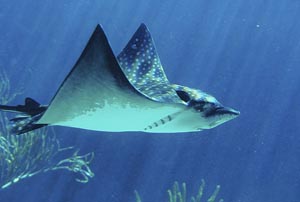 There are 19 species in this family. They are found in tropical and temperate ocean waters in the
Atlantic, Pacific, and Indian oceans. There are 19 species in this family. They are found in tropical and temperate ocean waters in the
Atlantic, Pacific, and Indian oceans.
They have long, triangular pectoral fins; long, whip-like tails with a small dorsal fin at the base, and a barbed venomous spine located behind their dorsal fin.
Unlike most rays, eagle rays flap their pectoral fins to propel themselves through the water! Some species, like the bat ray, can even leap up out of the water and skim along the water's surface! The rays in this family eat mollusks, fish, and crustaceans. World Status Key
 Least Concern Least Concern  Near Threatened Near Threatened  Vulnerable Vulnerable  Endangered Endangered  Critically Endangered Critically Endangered  Extinct in Wild Extinct in Wild  Extinct Extinct
Status and range is taken from ICUN Redlist. If no status is listed, there is not enough data to establish status.
US Status Key
 Threatened in US Threatened in US  Threatened in NH Threatened in NH  Endangered in US Endangered in US  Endangered in NH Endangered in NH  Introduced Introduced
Status taken from US Fish and Wildlife and NH Fish and Game
New Hampshire Species |
|
North/Central American Species |
| None |
|
Spotted Eagle Ray - Aetobatus narinari 
Bat Ray - Myliobatis californicus 
Bullnose Ray - Myliobatis freminvillii
Southern Eagle Ray - Myliobatis goodei
Longnose Eagle Ray - Myliobatis longirostris 
Roughskin Bullray - Pteromylaeus asperrimus |
Additional Information Resource Key
 Profile Profile  Photos Photos  Video Video  Audio Audio
Australian Eagle Ray - Myliobatis australis      
The Australian eagle ray is also known as the Australian bull ray. It is only found in the waters off southern Australia.
Source: Florida Museum of Natural History Intended Audience: General Reading Level: Middle/High School Bat Ray - Myliobatis californicus     
The bat ray is found in the Pacific ocean from Oregon south to Baja California, Mexico.
Source: Arkive Intended Audience: General Reading Level: Middle School
Bat Ray - Myliobatis californicus     
The bat ray is usually found in shallow water.
Source: Florida Museum of Natural History Intended Audience: General Reading Level: Middle/High School
Bullnose Ray - Myliobatis freminvillii     
The bullnose ray is found from Cape Cod to the southeastern coast of the Florida off the U.S. It has also been reported in waters off southern Brazil and northern South America as well as in the waters of the Caribbean and the Gulf of Mexico.
Source: Florida Museum of Natural History Intended Audience: General Reading Level: Middle/High School
Common Eagle Ray - Myliobatis aquila       
The common eagle ray is found in tropical to warm temperate waters along coastlines in shallow lagoons, bays and estuaries
Source: Florida Museum of Natural History Intended Audience: General Reading Level: Middle/High School Spotted Eagle Ray - Aetobatus narinari            
The spotted eagle ray is found in warm temperate and tropical waters around the world.
Source: Arkive Intended Audience: General Reading Level: Middle School
Spotted Eagle Ray - Aetobatus narinari            
The spotted eagle ray gets its name from the white, bluish-white, greenish, pearly, or yellow spots on the upperside of its body.
Source: Florida Museum of Natural History Intended Audience: General Reading Level: Middle/High School
|

